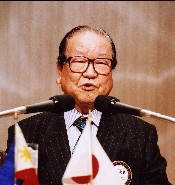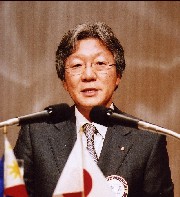Initiation Speech
November 22, 2006
Mr. Kosuke Yamamoto
Mr. Makoto Ishigaki
 ��Wise Approach to Resolving Disputes��
��Wise Approach to Resolving Disputes��
Mr. Kosuke Yamamoto,
President,
The Japan Commercial Arbitration Association (JCAA)
In 2003, a new arbitration law was enacted, which is the first revision in 120 years. To encourage the nation��s ��mediation,�� new Alternative Dispute Resolution Law was also enacted in 2004.
In the ��arbitration�� system, the ruling of the arbitrator would become a final decision under the agreement of each party. On the other hand, in the ��mediation�� system, the mediator aims to assist disputing parties in reaching an agreement. The arbitration process is used in most international disputes, whereas the mediation process is used in most domestic disputes.
The reasons ADR can be much more recommended than a lawsuit are as follows:
1)ADR acts rapidly. JCAA basically provides a conclusion for the mediation in Japan within three months.
2)Inexpensive petition. Because JCAA commissions a mediator familiar with the situation, very few of each party hires lawyers.
3)Obtaining the most reasonable resolution in the present situation is the purpose, not winning or losing legally.
4)A Court trialis basically open, whereas the mediation is private. The mediator protects confidentiality rules, so the resolution will not have a materialeffect on the business relationship between the parties afterwards.
5)Each party can select a mediator with skills and knowledge, depending on the business in dispute.
In Europe and the U.S., the use of either ADR or lawsuit is evenly divided as a method of dispute resolution. Japanese are generally thought as court-averse. They often take reluctant concessions, away from judicial resolutions. I am expecting that ADR will be common to those people and help them resolve any dispute in a positive and friendly manner.
I would like to add that in Japan a judge is involved in the civil mediation and court proceedings for the family affairs at a court. Because the majority of the cases are inexpensive and mainly focused on individuals, the cases cannot be categorized into the ADR objectives
 ��Propellant for Water Jet Vessels��
��Propellant for Water Jet Vessels��
Mr. Makoto Ishigaki,
President, ISHIGAKI COMPANY, LTD.
Overview
Only several dozen companies in the world are manufacturing propellers for water jet vessels, and three of them are Japanese. In the manufacturing technique, the patent was granted in the 17th century and the business has been well underway since the U.S. Navy started the development of water jetfoils in 1960s. In Japan, a ��Jetfoil�� is sailing from Tokyo to Izu Oshima Island and from Niigata to Sado Island. And between Hakata and Pusan (South Korea), a speed of 43 knots (80km/ph) is achieved; it takes three hours.
Structure
Water Jet vessels are operated by jet-injecting water taken in from the bottom of the ship with a high-pressure pump to the rear of the ship. The force obtained in this way becomes the power to propel the ship. The direction can be changed by steering the flow of the jet injection.
Features
Because water jet introduces a pumping structure, cavition will not readily occur. This advantage permits the water jet to accelerate the speed nearly up to 100km/ph. The water jet does not have any projection on the bottom surface of the ship, allowing the ship to sail on the shallows. The jet also allows sudden stops, sudden starts, and sudden turns, corresponding to the situations.
Applications
The Japan Coast Guard employs water jet vessels as a high-speed patrol ship. Many of these capable of 40 knots or higher are being manufactured. The Ministry of Land, Infrastructure, and Transport also introduced the vessels to probe rivers and streams at a low depth of water. In Okinawa, the advantage of sailing without any damage to coral reefs is being used. Many diving boats are equipped with the water jet as a safety precaution for divers. Watercraft also employs the jet system for its safety and maneuverability. In foreign countries, larger car ferries of more than 100 meters are sailing on Mediterranean Sea. A water jet is applied in many fields.
Progress in development
The U.S. is promoting a transpacific plan, which is to introduce five water jets, which will be 265 meters long with an output of 68,000ps, to carry high-speed cargos. The development of larger and faster water jet vessels is expected to continue, as the plan for the next generation of high-speed vessels has been adopted.